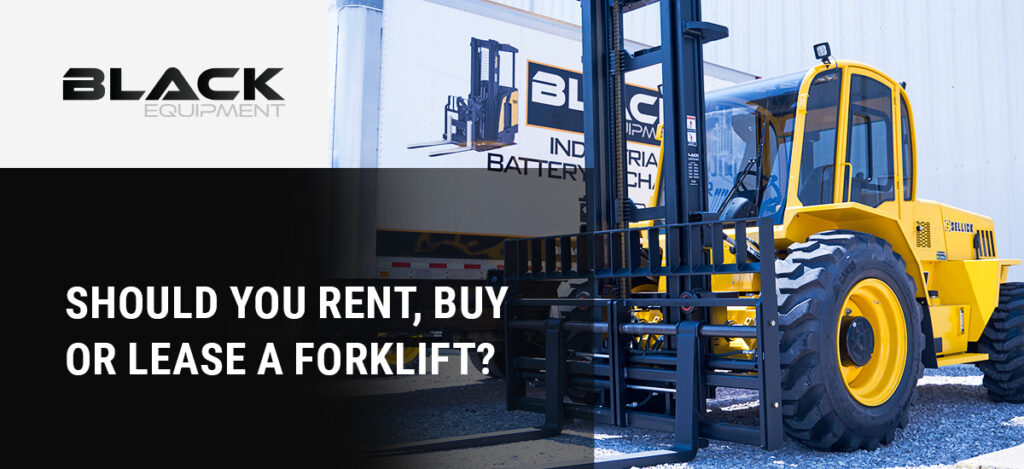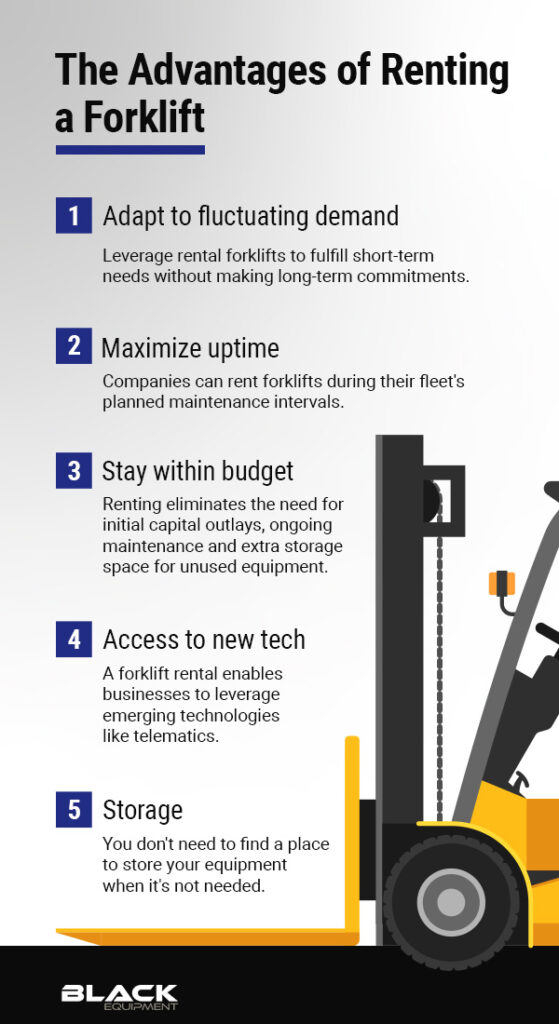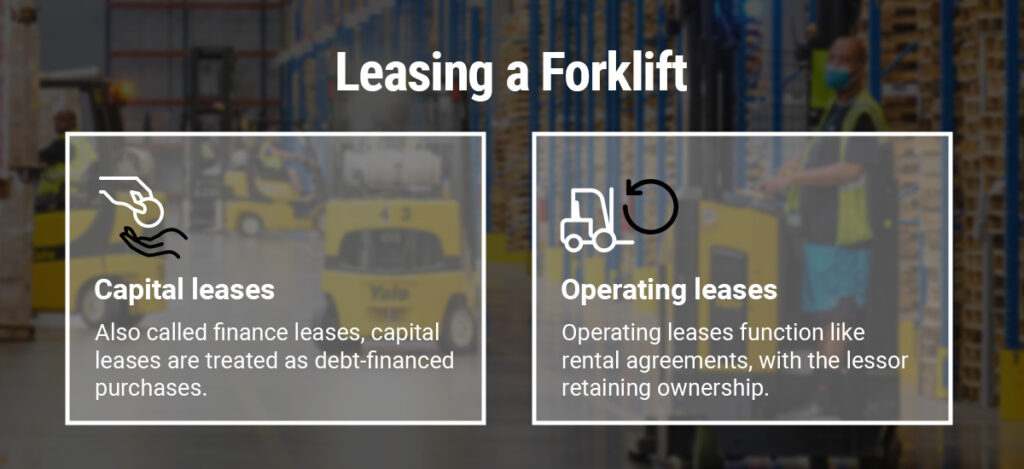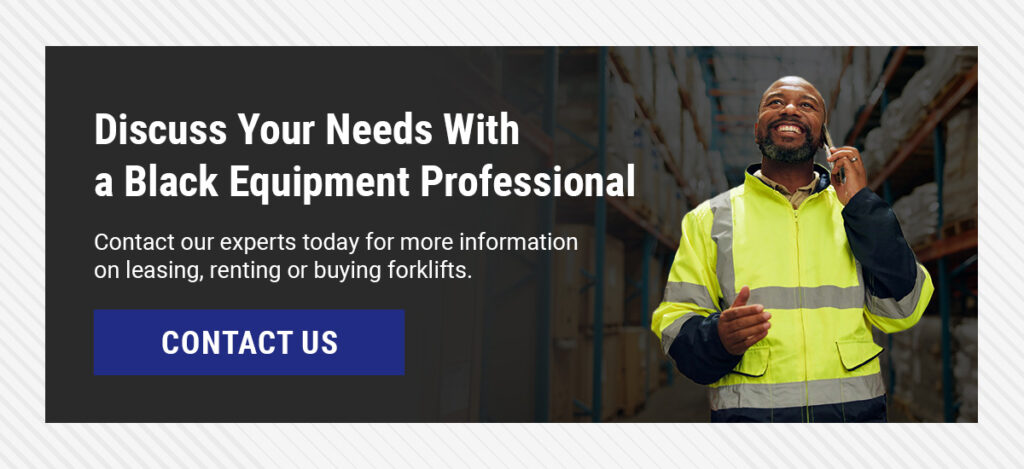Should You Rent, Buy or Lease a Forklift?

When demand changes or equipment reaches the end of its useful life, companies must decide between three equipment procurement models to keep operations running efficiently. Deciding to buy, lease or rent equipment depends on how long it’s needed, the company’s budget and the overall goals of the acquisition. This guide provides valuable insight into choosing between renting, buying or leasing a forklift.
Renting a Forklift
A forklift rental can be a convenient solution for crews needing to fill temporary gaps or accommodate seasonal spikes in demand.
Several steps make up the typical rental process:
- Initial inquiry: The business inquires with a rental company about their availability, rates and contract terms.
- Quote: The rental company provides the inquiring business with a quote that includes all costs associated with the rental.
- Contract review: The renter reviews and signs the rental agreement.
- Delivery: Some rental companies deliver equipment to the jobsite to make the experience more convenient for the renter.
- Operation: The renter uses the equipment during the rental period according to the provider’s terms and conditions.
- Return: The renter schedules a pickup by the rental company or returns the equipment at the end of the period. If allowed, the renter may also extend the rental or return the equipment early.
While forklift rentals are advantageous over purchases in many scenarios, they can be more costly in others. A rental is best for short-term use, such as filling gaps within an existing fleet or maintaining operations during planned maintenance intervals. Rentals eliminate the need for ongoing maintenance and storage you would otherwise require for purchased equipment when it’s not being used.
The Advantages of Renting a Forklift

Companies that leverage strategic rental agreements can:
- Adapt to fluctuating demand: Industries that experience significant changes in demand, such as warehousing and third-party logistics (3PL), can leverage rental forklifts to fulfill short-term needs without making long-term commitments.
- Maximize uptime: Companies can rent forklifts during their fleet’s planned maintenance intervals to keep operations running even when equipment is down. Rental companies that include delivery and pickup in their rental costs can further reduce costs and increase uptime by eliminating the need for staff to travel.
- Stay within budget: Renting eliminates the need for initial capital outlays, ongoing maintenance and extra storage space for unused equipment.
- Access to new tech: A forklift rental enables businesses to leverage emerging technologies like telematics and operator assist systems, which can enhance fleet capabilities in peak seasons.
- Storage: Since you tend to rent forklifts for temporary extra demand, you don’t need to find a place to store your equipment when it’s not needed.
It’s also important to address the benefits of attachment rentals. Renting attachments like sideshifters, clamps and layer pickers enables businesses to expand the functionality of the forklifts they own for one-time applications.
The Disadvantages of Renting a Forklift
Organizations considering a forklift rental should account for these potential drawbacks:
- Not appropriate for long-term projects: Rentals are most cost-effective in the short term, from one day to one year. In extreme situations, multiple rental agreement renewals can exceed the cost of buying a new forklift.
- No guarantee of availability: Unless a rental is scheduled well in advance, another business might rent out the necessary forklift.
- Rental company usage restrictions: Rental companies impose limitations on how customers can use their forklifts, which could make it more difficult for renters to integrate the lift into their typical workflow. Renters are also not allowed to customize the lifts as they would be able to with ones they own.
Businesses that need a forklift for more than one year would likely benefit from buying or leasing equipment.
Buying a Forklift
The decision between buying and renting depends on an organization’s budget and operational requirements. If a business needs a forklift for everyday operations, buying is a wiser and more cost-effective option. Organizations that only need a lift for a short period or for occasional projects should rent to minimize ownership costs.

While buying new forklifts can be costly, businesses also have the option to purchase used equipment at a lower price to stay within budget. Many equipment dealers offer flexible financing options to make new and used equipment purchases more affordable.
The Advantages of Buying a Forklift
Purchasing a forklift comes with various benefits:
- Depreciation-related tax benefits: Because equipment is considered a capital asset, companies can depreciate equipment purchases by deducting a portion of the cost on their tax returns over multiple years.
- Maintenance scheduling: Preventive maintenance intervals are established, which can help businesses plan maintenance intervals around normal operations.
- Customization: Lift owners can customize their equipment any way they see fit, which can enhance branding, functionality and efficiency.
- Cost savings: Once the forklift is paid off, the cost of operating the lift is significantly reduced.
- Guaranteed availability: Owning a forklift means accessing it whenever necessary. With rentals, it can be difficult to predict whether the lift will be available at the right time, not to mention the need to plan and arrange delivery in advance of when you’ll need it.
- Return on investment (ROI): Buying a forklift that crews use frequently enhances productivity and efficiency on the jobsite, potentially resulting in a higher ROI than renting or leasing.
Purchasing may be a viable option for businesses that are not worried about housing surplus stock or whose demand is more consistent.
The Disadvantages of Buying a Forklift
While buying a forklift offers flexibility and availability, it may not be the most suitable choice for a company due to several drawbacks:
- Increased operating costs: Businesses take on all associated ownership costs when they purchase a forklift, including maintenance, long-term storage and repairs. With a rental, the equipment provider handles these costs.
- Depreciating resale value: While tax depreciation offers ownership cost benefits through deductions, marketplace depreciation reduces the resale value of a forklift. This market-driven value loss is greater for used equipment, which depreciates more rapidly.
- Significant capital investment: The upfront cost of purchasing a new forklift can be higher than a business’s current budget may allow. While a used forklift may be more affordable, it could still cost more than a buyer is willing to pay. Financing plans or leasing options can help make the purchase more manageable, though terms depend on the equipment dealer.
If neither purchasing nor renting feels like the right fit, companies can lease equipment.
Leasing a Forklift
Leasing is a middle ground between buying and renting that enables companies to access necessary equipment without a significant upfront investment. Companies can use a lift truck for a predefined period and then buy the lift, renew the lease or return the equipment at the end of the contract.

Lessors often use one or both of the two main lease types:
- Capital leases: Also called finance leases, capital leases are treated as debt-financed purchases. The lessee assumes the risks and rewards of ownership but typically gains full ownership only at the end of the lease term, which spans most of the equipment’s useful life.
- Operating leases: Operating leases function like rental agreements, with the lessor retaining ownership and leasing the equipment to the lessee for a term shorter than its useful life. The lessee returns the lift at the end of the lease period and does not assume ownership risks.
Leasing can benefit businesses with tight budgets and long-term projects. However, it’s important to revisit the advantages and look at potential drawbacks specific to leasing.
The Advantages of Leasing a Forklift
Leasing a forklift can benefit a business in several ways:
- Quick access to needed equipment: Operating leases can be beneficial for companies that must keep up with the latest forklift technologies because they allow for quick upgrades without the capital investment of a purchase.
- Low startup costs: Because the customer doesn’t own rented or leased equipment outright, both arrangements often cost less upfront than purchasing a new or used piece of equipment.
- Longer leasing agreement: Companies that need a forklift for projects lasting longer than one year can use operating leases to access the lifts they need without purchasing the equipment. The most common lease terms last three, seven or 10 years and treat payments as a flat rental fee.
- Potential for tax benefits: Businesses may be able to deduct monthly lease payments from their annual taxes, depending on the type of lease and the location.
With a strategic lease plan, businesses enjoy the latest available models without needing to constantly renew short-term rental agreements. However, rather than holding on to the equipment as it depreciates, an operational lease enables a company to switch its leased forklift for a newer model at the end of the agreement.
A capital lease enables businesses to treat their leased forklifts as business assets. This plan allows them to lower taxes and gain the ability to resell the lift at the end of the lease term.
The Disadvantages of Leasing a Forklift
Prospective lessees should consider the most significant drawbacks of leasing equipment before making a final decision:
- Hidden fees: Additional fees in the lease term can drive costs up. Capital leases charge interest separately to compensate the lessor for financing the equipment over time. Operating leases often factor in a financing cost when setting the lease rate, though they don’t include this upcharge as a separate interest fee.
- Higher long-term costs: While short-term rentals often have higher monthly payments, their total cost is typically lower than leasing for brief usage periods due to fewer additional fees. However, leasing — particularly long-term capital leases with high interest rates or repeated operating leases — can result in total payments exceeding the cost of purchasing a new forklift outright. Businesses should compare lease terms, interest rates and the total cost of ownership, including financing for purchases, to determine the most cost-effective option.
- Less flexibility: Lessees can’t customize or operate their equipment beyond what their contract explicitly allows, and they must keep the equipment until the lease contract is over. However, once the lessee gains ownership of the lift after a capital lease ends, they’re free to adapt the equipment however they see fit.
- Extra maintenance costs: Unlike with rental agreements, maintenance typically is not included in leases without incurring additional costs. However, companies can lease a forklift with or without lessor-provided maintenance services.
Businesses should consult their equipment company before taking out a lease to understand the terms of the agreement and identify any hidden fees. This step can help eliminate any unexpected charges and ensure a more streamlined lease.
How to Find a Reliable Equipment Dealer
It’s critical to find a capable dealer that supports specific company needs and preferences. Fleet managers and business owners should look for certain signs when evaluating dealers to buy, rent or lease from:
- Reputation and experience: Reputable, established equipment dealers with multiple years of industry experience can better understand equipment needs and recommend the best options. Black Equipment has been recognized for excellence within the Hyster-Yale dealer network for more than 20 consecutive years and works with customers across various industries, including material handling, automotive and manufacturing.
- Financing options: Equipment dealers should offer flexible financing plans to make the cost of purchasing new equipment more manageable. Common financing options include leasing and paying in installments.
- Proven results: An equipment dealer with quantifiable evidence of success is a necessity. See how working with Black Equipment helped Hamilton Beach achieve a 274% increase in efficiency and an 80% reduction in product damage after relocating their distribution center.
- Consultative approach: The dealership team should meet with the business first to determine its needs and identify the best solution. The expert team at Black Equipment consults with all prospective customers to assess their requirements and recommend ideal solutions before every rental, lease or sale.
- Support and additional services: A dealer that offers comprehensive support and service options, such as operator safety training and professional fleet management services, can help businesses maximize their investment. Black Equipment provides various services, including repairs and maintenance.
Black Equipment offers the equipment you need, whether you’re looking for a one-month rental, a two-year lease or a purchase.
Discuss Your Needs With a Black Equipment Professional
The right equipment is crucial, and the specific method a company uses to obtain that equipment is a key consideration. The expert team at Black Equipment can help your business fulfill its material handling equipment needs.
Black Equipment provides everything from industry-leading forklifts to various lift truck attachments. Whether you purchase, rent or lease your equipment, you’ll get peace of mind from our simple guarantees.
Our trained team will work with you to assess your needs and identify the most appropriate industry solutions for your application. Contact our experts today for more information on leasing, renting or buying forklifts through Black Equipment. You can also visit one of our 11 locations across the Midwest and Southeast.
